You are interested in Philodendron pink princess care. In this guide will find everything from the best potting mix to watering and fertilizer for the Pink Princess Philodendron houseplant.
Philodendron Pink Princess Care Takeaways
| Species | Philodendron erubescens 'pink princess' |
| Synonyms | Philodendron Pink Princess |
| Family | Araceae |
| Genus | Philodendron |
| Growth | Self-heading |
| Height | 4 feet |
| Width | 2 feet |
| Soil | Well-draining highly organic soil |
| Watering | Water every 5 to 7 days |
| Light | Bright indirect |
| Temperature | 60 to 80°F |
| Humidity | 60-80% |
| Fertilizer | Fertilize 1 times per month |
| Propagation | Stem cuttings |
| Toxicity | Mildy toxic to humans and toxic to pets such as cats and dogs. Contains insoluble calcium oxalate crystals |
Table of Contents
Pink Princess Philodendron Care
The Pink Princess Philodendron prefers loose and well-draining organic soil. It needs bright indirect light. Water heavily when the top 2 inches of the soil dry up (5cm). The ideal temperature is between 60-80°F (16-27°C). The optimal humidity is between 60-80%. Use a balanced fertilizer every 4-6 weeks in spring and summer.
What is a Philodendron pink princess plant?
Philodendron ‘pink princess’ is a beautiful plant with pink and green leaf variegation. It is a cultivar of the Philodendron erubescens.
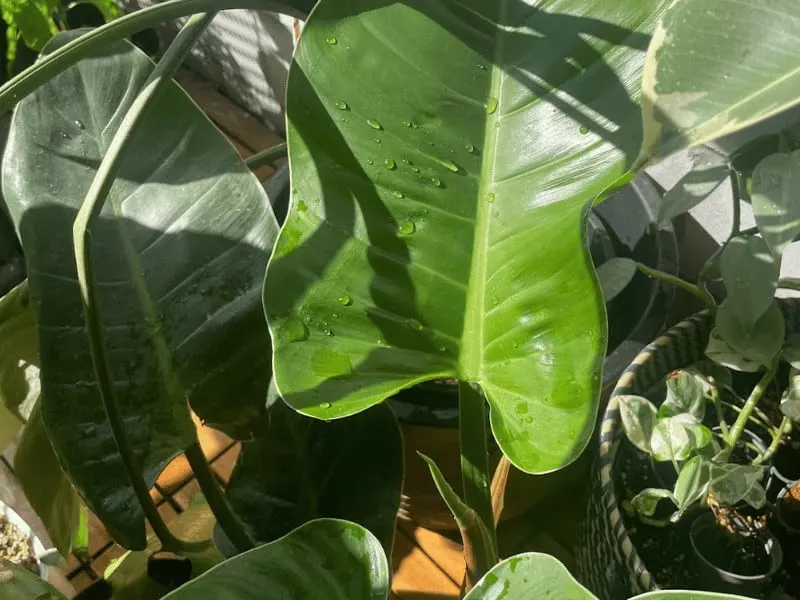
‘Erubescens’ means ‘blushing’ in Latin. The variegation of a Philodendron ‘pink princess’ is similar to the Pink Congo Philodendron. The difference is the variegation is not chemically induced but natural. The variegated leaves are also a darker pink compared to the blubblegum pink of Pink Congo Philodendron.
The Pink Congo has fully variegted leaves that will loose their coloring over time and turn into fully green leaves.
Pink princess philodendrons are Aroids or arums and are easy to care for. They are part of the Araceae family, according to Iowa State University.
Philodendron ‘pink princess’ Care Video
Philodendron Pink Princess Care Guide
Pink Princess Philodendron soil
Loose, well-draining soil that is rich in organic matter. These plants grow best in consistently moist soil. Choose a soil mix that retains moisture. It should not remain soggy. An Aroid potting mix is optimal.
The perfect soil medium drains quickly, holds adequate moisture, and is nutrient-rich.
Philodendron erubescens is native to the rainforests of South America, where they grow on the humus-rich forest floor.
The rainforest floor always holds abundant water, but the soil never is too soggy.
Diy Potting Mix:
- 40% peat moss or coco choir
- 30% orchid bark
- 20% perlite
- 10% worm castings
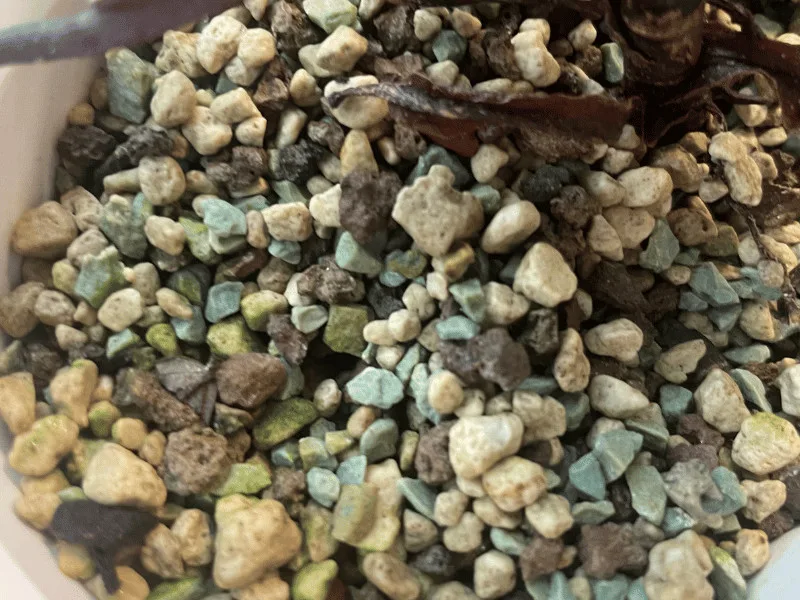
This soil mixture has a chunky texture and can still hold water. The peat moss or coco choir adds volume and retains moisture.
These organic materials act as a sponge and soak up excess water in the soil.
Orchid bark adds minute air pockets to the soil. They allow free growth space for the roots and good aeration.
Perlite is inorganic and allows quick-draining potting soil.
Worm castings or gardener’s gold adds nutrients.
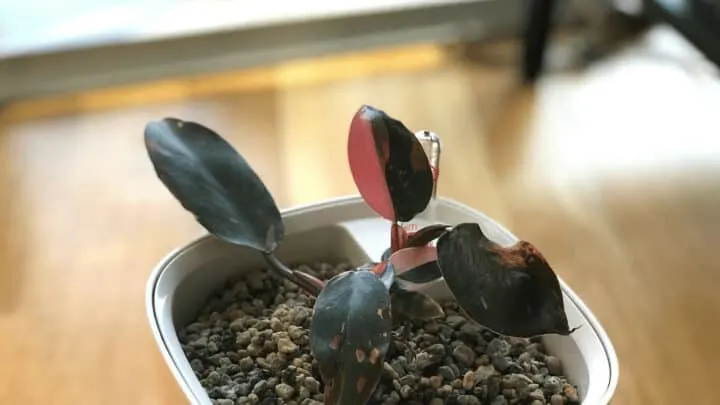
Light
Bright, indirect light. A few hours of direct sun in the early morning hours is fine. Keep the plant away from direct sun.
A minimum of 6 hours of bright indirect light is needed to increase variegation.
East or West-facing windows are ideal. Keep your pink princess away from too much sunlight.
Excessive direct sunlight can scorch the gorgeous foliage. Low light leads to slower growth.
The variegated parts of the foliage cannot produce chlorophyll. Photosynthesis happens through dark green color pigments.
Thus variegated plants need more light.
When growing outdoors, plant your Pink Princess in front of a North-facing wall. This shades it from the harsh sun throughout the day.
Allowing the plant to cling to tree trunks is also a good option. The canopy will provide much-needed protection from direct sun.
With low light levels, the Pink Princess will revert to mostly green leaves.
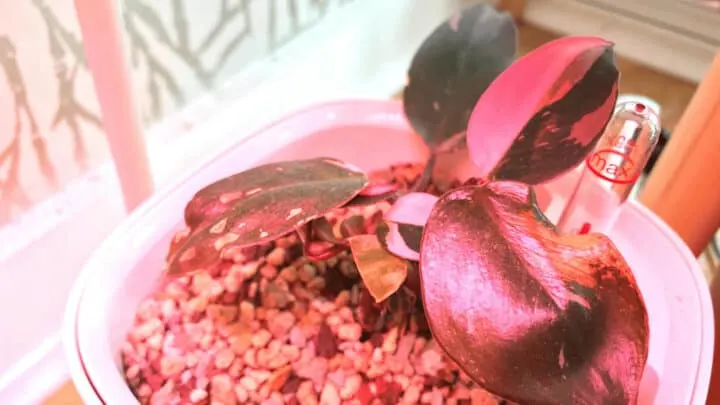
Pink princess philodendron watering
Water once a week when the top 1-2 inches of soil dry up (2.5-5cm). Stick your index finger into the soil. If the soil is dry, water until excess water flows out from the bottom.
Keep the soil adequately and consistently moist to keep the plant growing vigorously. Avoid soggy soil. You can also use a moisture meter. Keep the soil meter at 4.
Tap water in your area likely contains added salts, chlorine, and fluorides.
These minerals are not good for your plant. Leaves might curl up and dry from the edges of the plant if watered with hard tap water.
Let the water sit in an open container overnight so that the harmful chlorine evaporates. Alternatively, use rainwater, reverse osmosis water, or distilled water.
Temperature
The ideal temperature range is 60-80°F (16-27°C). If grown indoors, normal indoor temperatures are just fine. Pink Princess stops growing when temperatures dip below 55°F and are hardy to USDA Hardiness zone 9-10.
These plants will not tolerate cold temperatures. Extended exposure to temperatures below 40°F (4°C) can severely harm them.
In the same way, the delicate foliage of the ‘pink princess’ will not tolerate excessively high temperatures.
If you live in USDA zones 9 or 10, you can grow this plant outdoors throughout the year.
Humidity
The ideal humidity is 60-80%.
Usual indoor humidity levels are not high enough. Use a humidifier or pebble tray to fulfill the humidity needs. Alternatively, growers can place the plant in a bathroom with sufficient light.
High humidity, or atmospheric moisture, is important to keep your tropical plant well hydrated.
The leaves of a plant lose moisture to the atmosphere in a process called transpiration.
When atmospheric humidity levels are too low, the transpiration rate increases. Especially when the weather is hot.
Not being able to make up for the lost water through soil moisture absorption leads to leaves turning brown at the edges.
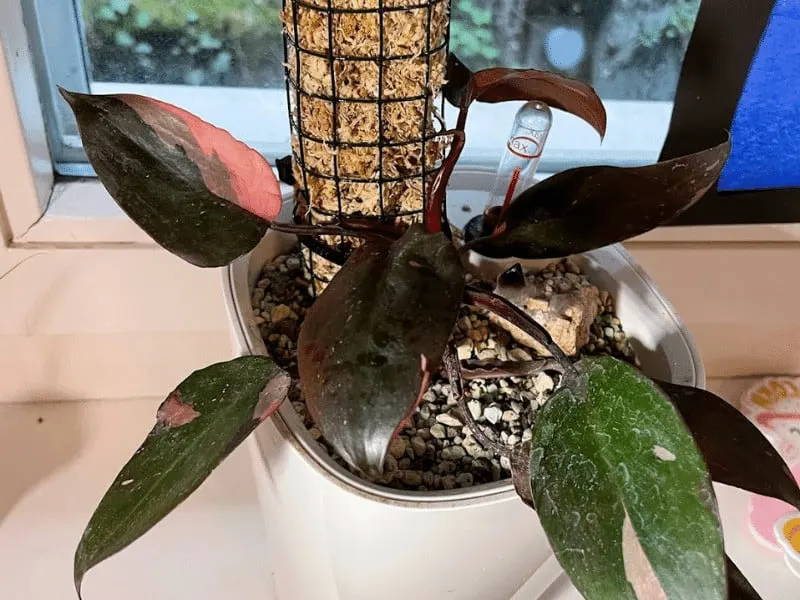
Fertilizer
Fertilize with a balanced liquid fertilizer every 4-6 weeks from spring to early fall.
The plant stops growing in the winter. It will not need any additive nutrients during this period of dormancy. Only feed the Princess during the growing season.
Use a balanced fertilizer with a 5-5-5 or 10-10-10 NPK soil nutrient ratio.
Avoid using a highly nitrogenous fertilizer.
A fertilizer with a high Nitrogen content will lead to fast growth. The new growth however will lack variegation.
Fertilizers with equal Phosphorous and Potassium content ensure increased pink parts.
Dilute the fertilizer to half-strength before you feed it.
Water the plant well before feeding.
Growth
This plant is s known for its rapid growth. It is vining along tree trunks in its natural habitat.
This plant has a vining, epiphytic growth habit. It grows aerial roots out of nodes and latches itself onto supporting structures.
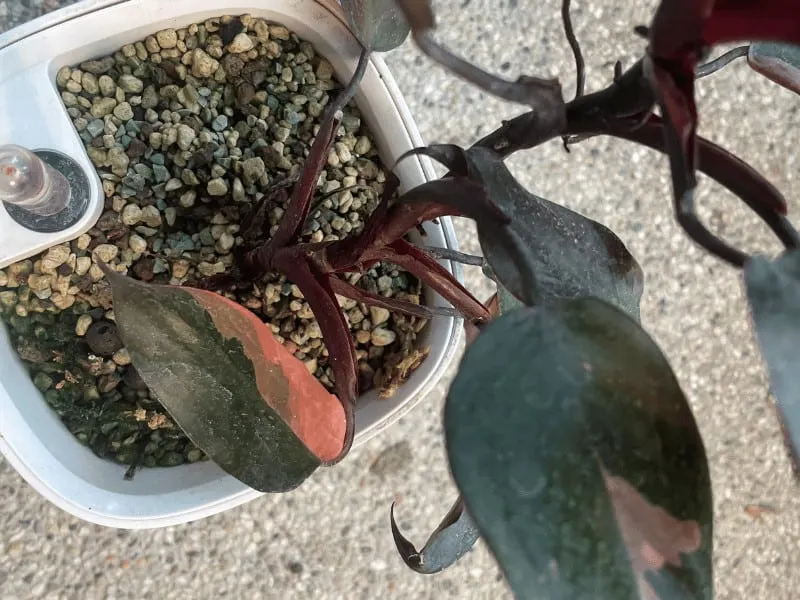
Potting and Repotting
Terra cotta pots are recommended over other materials for their breathability. The pot should be at least 2 inches (5cm) bigger in height and width than the rootball. Repot every one to two years.
The porous texture of terra cotta pots allows air exchange between the roots and the atmosphere.
These plants get rootbound after a year or two in the same pot.
Increase the pot size only by one or two sizes each time. Greater soil volume takes longer to dry out and will result in various moisture-related problems.
Pruning a PPP
Prune the plant in Spring. Prune off damaged or yellow leaves. Also, prune the plant if it looks too leggy. Use clean and sterilized shears.
If you notice your plant producing all green or all pink leaves, you can prune it to increase the chances of more variegation.
Blooming
The Pink Princess also blooms in the form of a spathe.
The Spathe isn’t a flower but a mutated leaf that functions to protect the spadix. The actual flowers are tiny in size and located on top of the spadix.
Pink Princess Propagation
PPP can be propagated through stem cuttings or plant division.
Propagation through cuttings
Step 1 – Prepare sharp and sterilized pruners, a water glass, and gloves
Step 2 – Check the stem and make out the nodes
Step 3 – Cut the main stem 6 inches (15 cm) from the end of the stem. This cut should be about ¼ of an inch below the node.
Step 4 – Place the cut stems into a glass of water. The lower nodes should be completely immersed in water while the leaves can be suspended over the water.
Step 5 – Place the cuttings in warm, brightly lit locations to ensure faster root growth.
Step 6 – The roots will develop a self-supporting root system in 4-5 weeks. Once the roots have developed, you can either pot them in potting mix or keep them in the water.
Step 7 – After potting the cuttings, ensure that the soil well surrounds the roots. Keep the cuttings warm for 2-3 weeks until the roots are established in the soil.
Propagation through division
To propagate a Pink Princess through division:
Step 1- Water the plant
Step 2 – Loosen up the soil once it is moistened properly
Step 3 – Take the rootball out of the pot and rake away the soil slowly as you explore the root system
Step 4 – Separate each plant with an established root system
Step 5 – Pot the plants in potting mix and put them in a warm, bright place.
Philodendron Pink Princess Pests
These are the most common pests on the Pink Princess:
- Mealybugs: White insects that look like cotton
- Thrips: Small black elongated insects that are small and hard to spot. Larvae are white
- Aphids: Brown to reddish. They can be spotted easily with your bare eyes.
- Scale: Sap-sucking insects that hardly move and attach mostly to stems. They have a hard body
- Spider mites: Small red spider-like creatures that build fine nets
- Whiteflies: Small white fly-like insects
- Fungus Gnats: Black, flying insects that prefer moist conditions
The best remedies to get rid of these bugs are:
- Neem oil: Expensive but repels several pests
- Horticultural soap: Great as a preventative measure as a constant remedy against pests
- Beneficial Nematodes: Good bugs against bad bugs. Each pest has at least one counterpart that you can use against it.
- Systemic Insecticide: Not good for the environment. Use with care when all else doesn’t work
Does a Pink Princess Philodendron need a moss pole?
The Pink Princess Philodendron should be provided with a moss pole. If this plant has a trellis or moss pole, the plant will grow in an upright direction. Other you risk leggy growth. In addition the leaves grow smaller if you do not provide support.
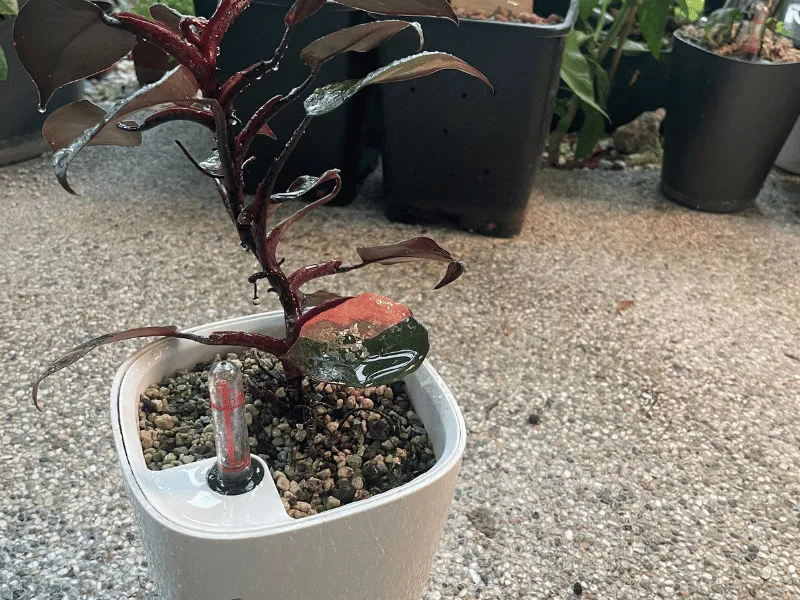
My Philodendron Pink Princess is Drooping Leaves
A Philodendron that cannot hold its leaves upright can have a few underlying reasons.
These symptoms most commonly arise if the plant gets too much or too little water. Diagnose the problem by checking the soil moisture.
If the soil seems wet and the plant is still drooping, the reason is overwatering. If the soil is dried, water your plant immediately.
It will also start drooping if placed in very low light or extreme heat.
My Pink Princess Plant has Brown Leaf Edges
The leaves of a Pink Lady are supposed to be dark green with a vibrant mixture of pinks.
Whenever you see a brown hue take over the edges or the entire leaf, the plant may face a shortage of humidity.
Check the humidity levels around the plant. Take needed measures. Add a humidifier or pebble tray.
Why is my Pink Princess Philodendron Not Pink?
A Pink Princess Philodendron is not pink because this plant’s variegation is unstable. Some leaves have more pink than others. Some of the foliage can be brown, red or green entirely without any pink.
A good indicator of how much pink a plant produces is the stem. If the stem is variegated and contians pink, the leaves will also contain variegation.
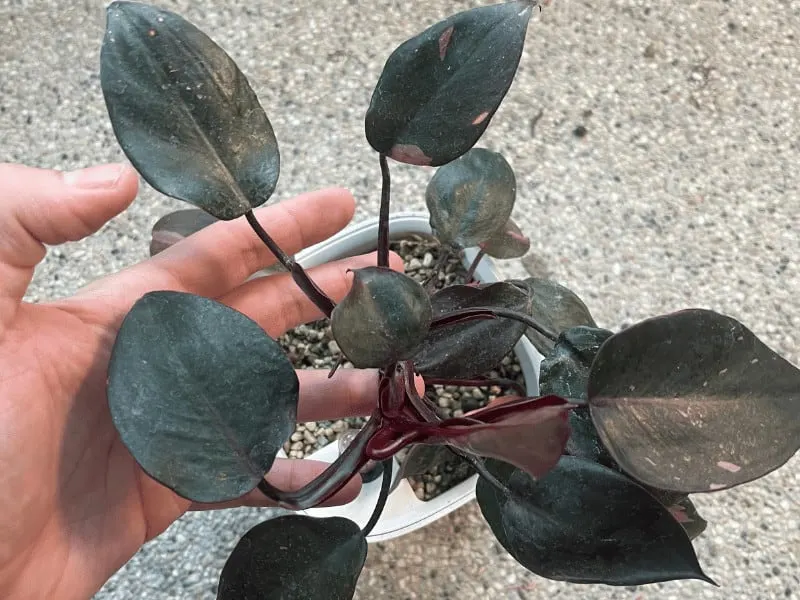
Remedy
A higher light intensity can help the plant to produce more pink. So put your houseplant in a bright spot in eaetern or western-facing window. If you still see no pink put the plant closer to the window. You can also use a grow light for your indoor plant.
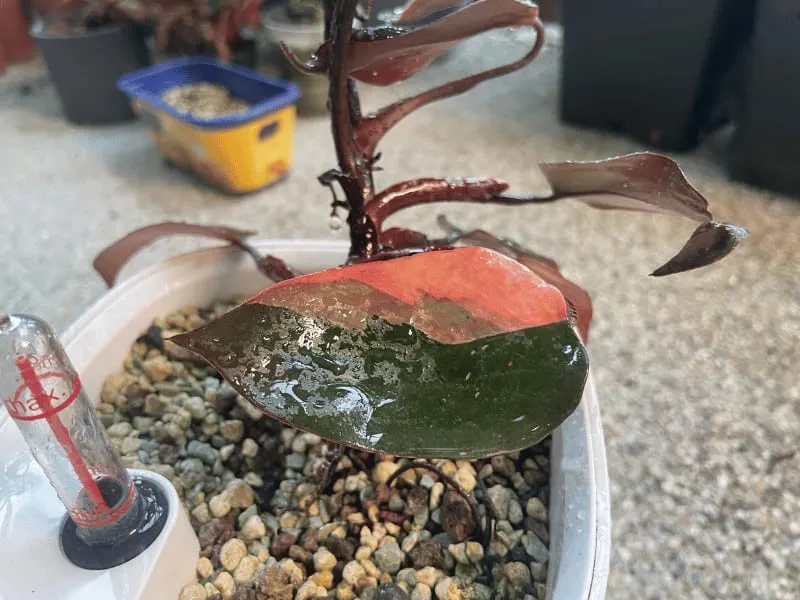
Does My Pink Princess Have Root Rot?
Root rot is caused by too much moisture in the soil. When the roots get insufficient oxygen, the PPP roots will rot and wilt.
If you see yellow leaves and observe stunted growth, check the roots. Take the plant out of the pot and remove the soil. Cut-off mushy roots and wash the remaining roots under running water. Disinfect the pot and use new potting soil.
Where to buy a Philodendron ‘pink princess’?
Pink Princess Philodendron can also be bought on Etsy, Facebook, and online stores such as Steves Leaves.
While they have become more affordable, they are often sold out. Nice specimens with lots of pink are hard to come by.
The Pink Princess is currently for sale here:
Is the Pink Princess Philodendron Toxic?
The Pink princess philodendron is toxic to cats and dogs and mildly toxic to humans. It contains insoluble calcium oxalate crystals that can lead to vomiting and swelling if ingested and will lead to skin irritation.
Philodendron Pink Congo
The Pink Congo is a pink plant that looks similar. It has entire leaves that are colored bubblegum pink. The Pink congo’s leaves are very bright pink. New leaves that emerge will start pink and then turn into a green color later on.
This is the result of an artificial process. This plant does not have natural variegation.
So, when buying a pink Philodendron, only spend your money on the Pink Princess with pink variegation and dark green colors on the same leaf.
The variegation in a Pink Princess is different
A PPP plant has hot pink variegation.
The underside of the leaves may appear bronze or chocolate-colored.
This is primarily due to the dark green and pink hues merging to produce a predominantly chocolaty color.
What is Philodendron Pink Princess Marble?
The Pink Princess Marble has a more freckled pink variegation than Philodendron Pink Princess. The marble is more expensive.
Frequently Asked Questions
Is the Pink Princess philodendron rare?
It is not considered a rare plant anymore. The increased demand led to a lot of newly produced plants recently.
How do you keep Pink Princess Philodendron pink?
To keep the PPP pink, provide lots of bright indirect sunlight. Variegated plants need more light than other plants. If too little light is provided, this Philodendron produces fewer variegated leaves.
How many types of Philodendron are there?
There are currently over 400 species known under the Philodendron genus. Philodendron belongs to the family Araceae.
Are dogs allergic to Philodendron Pink Princess?
All parts of the Pink Princess plant are poisonous to any animal if ingested. Ingesting part can cause drooling, coughing, foaming, and agitation of the skin around the face and mouth in dogs.
Why is Philodendron Pink Princess so expensive?
Philodendron ‘pink princess’ is expensive because producing a nice-looking plant with lots of pink variegation is not easy. The variegation is not stable and isn’t guaranteed. Therefore only a few of the produced plants can be sold. This increases the price.
Does the Pink Princess need sunlight?
The pink princess needs light to thrive and grow. Either sunlight or artificial light can be provided. It does best with bright indirect light or an artificial full-spectrum grow light.
Is pink Princess Philodendron natural?
It is natural and derived from a chimeric mutation. It was developed in the 70s and multiplied for the mass market. It is unlike the Pink Congo, where the pink coloration is chemically induced.
Conclusion About Philodendron Pink Princess Care
To care for this plant, provide the following:
- Well-draining soil
- Bright indirect light
- Water once the top 2 inches of soil are dry (5cm)
- Temperatures between 60-80°F (16-27°C)
- Humidity between 60-80%
- Fertilize every 4-6 weeks in spring and summer

Daniel has been a plant enthusiast for over 20 years. He owns hundreds of houseplants and prepares for the chili growing seasons yearly with great anticipation. His favorite plants are plant species in the Araceae family, such as Monstera, Philodendron, and Anthurium. He also loves gardening and is growing hot peppers, tomatoes, and many more vegetables.


